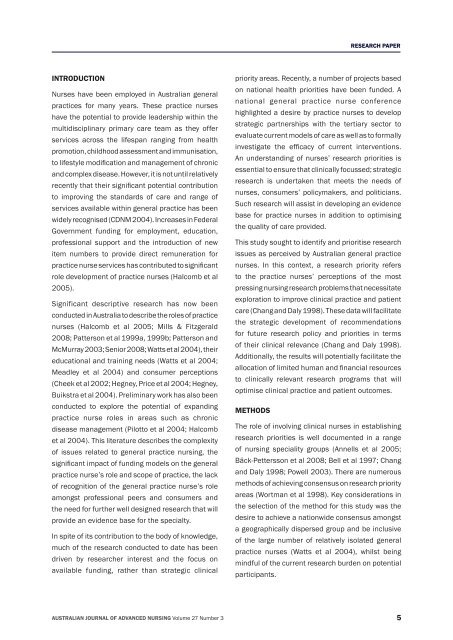March-May, 2010 - Australian Journal of Advanced Nursing
March-May, 2010 - Australian Journal of Advanced Nursing
March-May, 2010 - Australian Journal of Advanced Nursing
Create successful ePaper yourself
Turn your PDF publications into a flip-book with our unique Google optimized e-Paper software.
RESEARCH PAPER<br />
INTRODUCTION<br />
Nurses have been employed in <strong>Australian</strong> general<br />
practices for many years. These practice nurses<br />
have the potential to provide leadership within the<br />
multidisciplinary primary care team as they <strong>of</strong>fer<br />
services across the lifespan ranging from health<br />
promotion, childhood assessment and immunisation,<br />
to lifestyle modification and management <strong>of</strong> chronic<br />
and complex disease. However, it is not until relatively<br />
recently that their significant potential contribution<br />
to improving the standards <strong>of</strong> care and range <strong>of</strong><br />
services available within general practice has been<br />
widely recognised (CDNM 2004). Increases in Federal<br />
Government funding for employment, education,<br />
pr<strong>of</strong>essional support and the introduction <strong>of</strong> new<br />
item numbers to provide direct remuneration for<br />
practice nurse services has contributed to significant<br />
role development <strong>of</strong> practice nurses (Halcomb et al<br />
2005).<br />
Significant descriptive research has now been<br />
conducted in Australia to describe the roles <strong>of</strong> practice<br />
nurses (Halcomb et al 2005; Mills & Fitzgerald<br />
2008; Patterson et al 1999a, 1999b; Patterson and<br />
McMurray 2003; Senior 2008; Watts et al 2004), their<br />
educational and training needs (Watts et al 2004;<br />
Meadley et al 2004) and consumer perceptions<br />
(Cheek et al 2002; Hegney, Price et al 2004; Hegney,<br />
Buikstra et al 2004). Preliminary work has also been<br />
conducted to explore the potential <strong>of</strong> expanding<br />
practice nurse roles in areas such as chronic<br />
disease management (Pilotto et al 2004; Halcomb<br />
et al 2004). This literature describes the complexity<br />
<strong>of</strong> issues related to general practice nursing, the<br />
significant impact <strong>of</strong> funding models on the general<br />
practice nurse’s role and scope <strong>of</strong> practice, the lack<br />
<strong>of</strong> recognition <strong>of</strong> the general practice nurse’s role<br />
amongst pr<strong>of</strong>essional peers and consumers and<br />
the need for further well designed research that will<br />
provide an evidence base for the specialty.<br />
In spite <strong>of</strong> its contribution to the body <strong>of</strong> knowledge,<br />
much <strong>of</strong> the research conducted to date has been<br />
driven by researcher interest and the focus on<br />
available funding, rather than strategic clinical<br />
priority areas. Recently, a number <strong>of</strong> projects based<br />
on national health priorities have been funded. A<br />
national general practice nurse conference<br />
highlighted a desire by practice nurses to develop<br />
strategic partnerships with the tertiary sector to<br />
evaluate current models <strong>of</strong> care as well as to formally<br />
investigate the efficacy <strong>of</strong> current interventions.<br />
An understanding <strong>of</strong> nurses’ research priorities is<br />
essential to ensure that clinically focussed; strategic<br />
research is undertaken that meets the needs <strong>of</strong><br />
nurses, consumers’ policymakers, and politicians.<br />
Such research will assist in developing an evidence<br />
base for practice nurses in addition to optimising<br />
the quality <strong>of</strong> care provided.<br />
This study sought to identify and prioritise research<br />
issues as perceived by <strong>Australian</strong> general practice<br />
nurses. In this context, a research priority refers<br />
to the practice nurses’ perceptions <strong>of</strong> the most<br />
pressing nursing research problems that necessitate<br />
exploration to improve clinical practice and patient<br />
care (Chang and Daly 1998). These data will facilitate<br />
the strategic development <strong>of</strong> recommendations<br />
for future research policy and priorities in terms<br />
<strong>of</strong> their clinical relevance (Chang and Daly 1998).<br />
Additionally, the results will potentially facilitate the<br />
allocation <strong>of</strong> limited human and financial resources<br />
to clinically relevant research programs that will<br />
optimise clinical practice and patient outcomes.<br />
METHODS<br />
The role <strong>of</strong> involving clinical nurses in establishing<br />
research priorities is well documented in a range<br />
<strong>of</strong> nursing speciality groups (Annells et al 2005;<br />
Bäck‐Pettersson et al 2008; Bell et al 1997; Chang<br />
and Daly 1998; Powell 2003). There are numerous<br />
methods <strong>of</strong> achieving consensus on research priority<br />
areas (Wortman et al 1998). Key considerations in<br />
the selection <strong>of</strong> the method for this study was the<br />
desire to achieve a nationwide consensus amongst<br />
a geographically dispersed group and be inclusive<br />
<strong>of</strong> the large number <strong>of</strong> relatively isolated general<br />
practice nurses (Watts et al 2004), whilst being<br />
mindful <strong>of</strong> the current research burden on potential<br />
participants.<br />
AUSTRALIAN JOURNAL OF ADVANCED NURSING Volume 27 Number 3 5

















